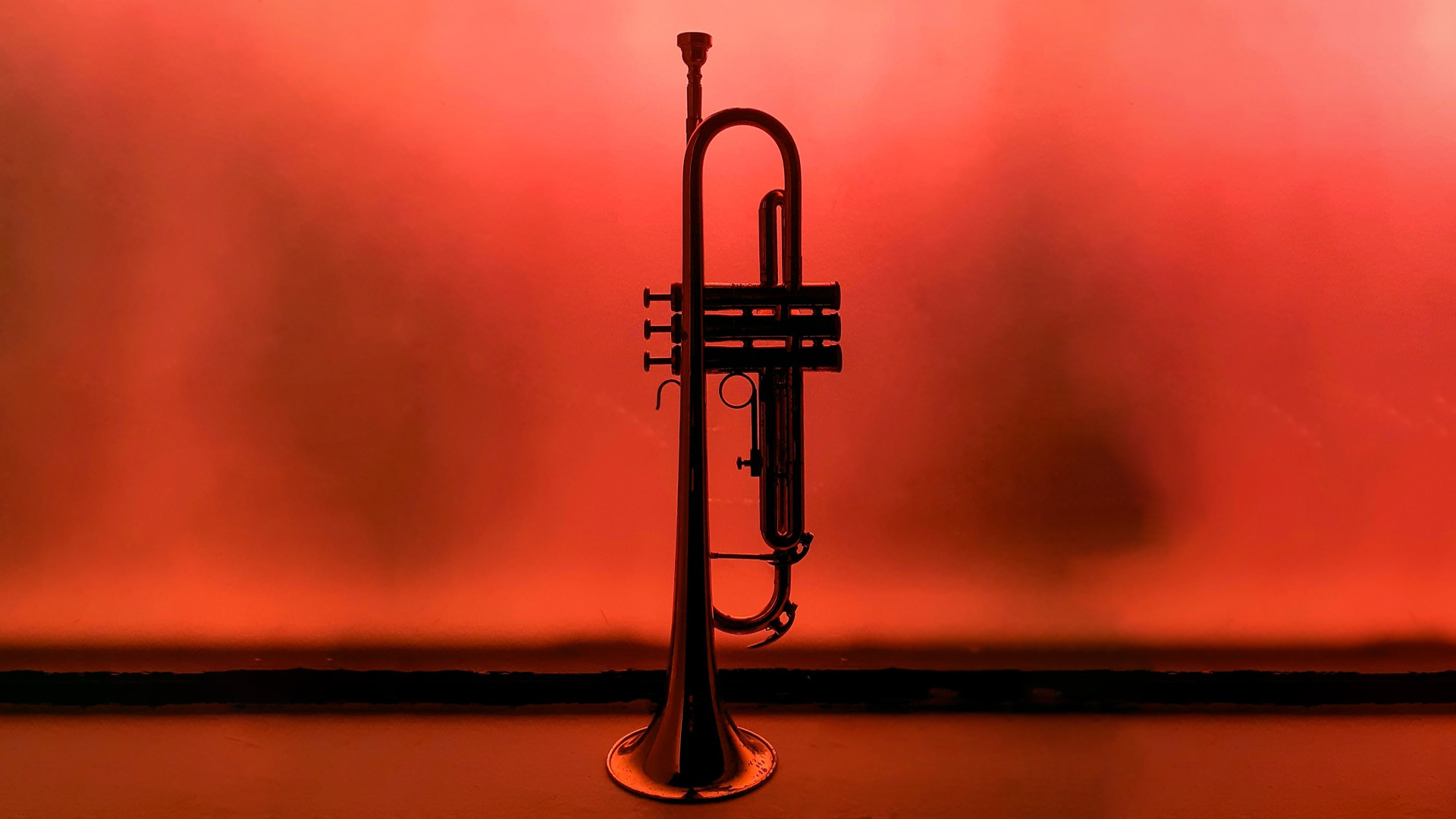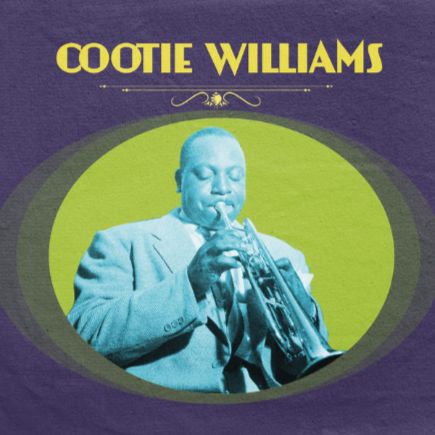Trompettiste de jazz et de rhythm and blues américain, de son vrai nom Charles Melvin Williams, ‘Cootie’ Williams est connu pour son style ‘jungle’ (à la manière de Bubber Miley, trompettiste d’Ellington et du tromboniste Joe ‘Tricky Sam’ Nanton), lorsqu’il faisait rugir sa trompette grâce à deux sourdines, la plunger mute (ventouse en caoutchouc), tenue de la main gauche pour obtenir l’effet ‘wah wah’, et une straight mute en aluminium fixée dans le pavillon. Il est également reconnu pour son jeu expressif et son innovation technique, et a marqué son époque par sa virtuosité et son impact sur l’évolution du swing, du big band et du rhythm and blues.
‘Cootie’ Williams a commencé sa carrière professionnelle à l’âge de quatorze ans avec le groupe Young Family, qui comprenait le saxophoniste Lester Young. En 1928 il fait ses premiers enregistrements avec le pianiste James P. Johnson à New York, où il travaille aussi brièvement dans les orchestres de Chick Webb et de Fletcher Henderson. Il se fait connaître en tant que membre de l’orchestre de Duke Ellington lorsque celui-ci se produit au Cotton Club, avec lequel il se produit de 1929 à 1940.
Il a également enregistré ses propres sessions durant cette période, à la fois en indépendant et avec d’autres sidemen d’Ellington. Pour lui, Ellington a écrit « Concerto for Cootie », une composition mettant en valeur son talent, qui deviendra plus tard le célèbre standard « Do Nothing Till You Hear From Me », avec des paroles ajoutées.
En 1940, ‘Cootie’ Williams a rejoint l’orchestre de Benny Goodman, une décision très médiatisée qui a fait sensation à l’époque (commémorée par Raymond Scott avec la chanson « When Cootie Left the Duke »), puis, en 1941, il a formé son propre orchestre, dans lequel il a employé au fil des ans Charlie Parker, Eddie « Lockjaw » Davis, Bud Powell, Eddie Vinson et d’autres jeunes musiciens.
Parmi ses succès de cette période, le morceau « ‘Round Midnight » de Thelonious Monk reste une interprétation remarquable, montrant sa capacité à transcender les styles et à s’adapter aux évolutions du jazz. Dans les années 1950, il a commencé à jouer davantage de rhythm and blues, a fait des tournées avec de petits groupes et a joué au Savoy Ballroom.
À la fin des années 1950, il forme un petit groupe de jazz et enregistre un certain nombre d’albums avec Rex Stewart, ainsi que son propre album, « Cootie Williams in Hi-Fi » (1958). En 1962, il rejoint Ellington et reste avec l’orchestre jusqu’en 1974, après la mort d’Ellington. ‘Cootie’ Williams a acquis son surnom de garçon quand son père l’a emmené à un concert; quand c’était fini, son père lui demanda ce qu’il avait entendu et il répondit: « Cootie, cootie, cootie » (poux).
Trompetista de jazz y rhythm and blues estadounidense, cuyo verdadero nombre era Charles Melvin Williams, ‘Cootie’ Williams es conocido por su estilo ‘jungle’ (a la manera de Bubber Miley, trompetista de Ellington, y del trombonista Joe ‘Tricky Sam’ Nanton), cuando hacía rugir su trompeta gracias al uso combinado de dos sordinas: la plunger mute (ventosa de goma), sostenida con la mano izquierda para lograr el efecto ‘wah wah’, y una straight mute de aluminio fijada en el pabellón. También es reconocido por su interpretación expresiva y su innovación técnica, dejando una huella imborrable en la evolución del swing, las big bands y el rhythm and blues.
‘Cootie’ Williams inició su carrera profesional a los catorce años con el grupo Young Family, donde también tocaba el saxofonista Lester Young. En 1928 realizó sus primeras grabaciones con el pianista James P. Johnson en Nueva York, donde trabajó brevemente con las orquestas de Chick Webb y Fletcher Henderson. Su salto a la fama llegó como miembro de la orquesta de Duke Ellington, con quien actuó en el mítico Cotton Club entre 1929 y 1940.
Durante este período, además de grabar con Ellington, realizó sesiones como líder, colaborando con otros músicos de la banda. Ellington compuso para él « Concerto for Cootie », una pieza que mostraba su virtuosismo y que más tarde se convirtió en el famoso estándar « Do Nothing Till You Hear From Me » con la adición de letra.
En 1940, ‘Cootie’ Williams se unió a la orquesta de Benny Goodman, un hecho que causó sensación en su época (conmemorado por Raymond Scott en su canción « When Cootie Left the Duke »). En 1941 formó su propia banda, que a lo largo de los años contó con jóvenes talentos como Charlie Parker, Eddie « Lockjaw » Davis, Bud Powell y Eddie Vinson.
Entre sus éxitos de esta época destaca su interpretación de « ‘Round Midnight » de Thelonious Monk, que demuestra su capacidad para trascender estilos y adaptarse a la evolución del jazz. En los años 50, se orientó más hacia el rhythm and blues, realizando giras con pequeños grupos y tocando en el Savoy Ballroom.
A finales de la década, formó un pequeño grupo de jazz y grabó varios álbumes, incluido « Cootie Williams in Hi-Fi » (1958). En 1962 volvió a unirse a Ellington, permaneciendo en su orquesta hasta 1974, tras la muerte del maestro. El apodo « Cootie » lo recibió de niño: tras asistir a un concierto, cuando su padre le preguntó qué había escuchado, respondió: « Cootie, cootie, cootie » (piojos).
Trombettista jazz e rhythm and blues statunitense, il cui vero nome era Charles Melvin Williams, ‘Cootie’ Williams è noto per il suo stile ‘jungle’ (alla maniera di Bubber Miley, trombettista di Ellington, e del trombonista Joe ‘Tricky Sam’ Nanton), quando faceva ruggire la sua tromba grazie all’uso combinato di due sordine: la plunger mute (una ventosa di gomma), tenuta con la mano sinistra per creare l’effetto ‘wah wah’, e una straight mute di alluminio fissata nella campana dello strumento. È inoltre riconosciuto per la sua espressività e innovazione tecnica, lasciando un segno indelebile nell’evoluzione dello swing, delle big band e del rhythm and blues.
‘Cootie’ Williams iniziò la sua carriera professionale a quattordici anni con il gruppo Young Family, che includeva anche il sassofonista Lester Young. Nel 1928 registrò i suoi primi brani con il pianista James P. Johnson a New York, dove collaborò brevemente con le orchestre di Chick Webb e Fletcher Henderson. La notorietà arrivò come membro dell’orchestra di Duke Ellington, con cui si esibì al leggendario Cotton Club dal 1929 al 1940.
In questo periodo, oltre a suonare con Ellington, registrò anche come leader, collaborando con altri musicisti della band. Per lui, Ellington scrisse « Concerto for Cootie », un brano che metteva in risalto il suo talento e che più tardi divenne il celebre standard « Do Nothing Till You Hear From Me » con l’aggiunta di un testo.
Nel 1940, ‘Cootie’ Williams si unì all’orchestra di Benny Goodman, una decisione molto discussa all’epoca (commemorata da Raymond Scott con il brano « When Cootie Left the Duke »). Nel 1941 formò la sua orchestra, che negli anni accolse giovani talenti come Charlie Parker, Eddie « Lockjaw » Davis, Bud Powell e Eddie Vinson.
Tra i suoi successi di questo periodo spicca l’interpretazione di « ‘Round Midnight » di Thelonious Monk, che dimostra la sua capacità di adattarsi ai cambiamenti nel jazz e di attraversare stili diversi. Negli anni ’50, Williams si avvicinò al rhythm and blues, facendo tournée con piccoli gruppi e suonando al Savoy Ballroom.
Alla fine del decennio formò un piccolo gruppo jazz e registrò diversi album, tra cui « Cootie Williams in Hi-Fi » (1958). Nel 1962 tornò con Ellington, restando nella sua orchestra fino al 1974, dopo la morte del grande direttore. Il soprannome « Cootie » lo ricevette da bambino: dopo un concerto, alla domanda del padre su cosa avesse ascoltato, rispose: « Cootie, cootie, cootie » (pidocchi).
American jazz and rhythm and blues trumpeter Charles Melvin Williams, known as ‘Cootie’ Williams, is celebrated for his ‘jungle’ style (inspired by Bubber Miley, Ellington’s trumpeter, and trombonist Joe ‘Tricky Sam’ Nanton), when he made his trumpet growl by using two mutes: the plunger mute (a rubber suction cup), held in his left hand to create the ‘wah wah’ effect, and a straight mute made of aluminum fixed in the bell. He is also renowned for his expressive playing, technical innovation, and his significant impact on the evolution of swing, big band, and rhythm and blues.
‘Cootie’ Williams began his professional career at the age of fourteen with the Young Family band, which included saxophonist Lester Young. In 1928, he made his first recordings with pianist James P. Johnson in New York, where he also briefly worked with the orchestras of Chick Webb and Fletcher Henderson. He rose to prominence as a member of Duke Ellington’s orchestra, performing at the legendary Cotton Club from 1929 to 1940.
During this time, he also recorded as a bandleader, collaborating with Ellington’s sidemen. Ellington composed « Concerto for Cootie » to showcase his talent, which later became the classic standard « Do Nothing Till You Hear From Me » with lyrics added.
In 1940, ‘Cootie’ Williams joined Benny Goodman’s orchestra, a highly publicized move commemorated by Raymond Scott’s « When Cootie Left the Duke ». In 1941, he formed his own band, which over the years featured emerging talents such as Charlie Parker, Eddie « Lockjaw » Davis, Bud Powell, and Eddie Vinson.
One of his standout performances during this period was his interpretation of « ‘Round Midnight » by Thelonious Monk, demonstrating his ability to transcend styles and adapt to jazz’s evolving soundscape. In the 1950s, Williams shifted toward rhythm and blues, touring with small groups and performing at the Savoy Ballroom.
By the late 1950s, he formed a small jazz group and recorded several albums, including « Cootie Williams in Hi-Fi » (1958). In 1962, he rejoined Ellington, remaining with the orchestra until 1974, after Ellington’s death. Williams earned the nickname « Cootie » as a child when, after attending a concert with his father, he responded to his father’s question about what he had heard by saying, « Cootie, cootie, cootie » (lice).

Autres articles – Otros artículos – Altri articoli
Eddie « Lockjaw » DAVIS (02.03.1922–03.11.1986)
Duke ELLINGTON (29.04.1899–24.05.1974)
Benny GOODMAN (30.05.1909–13.06.1986)
Fletcher HENDERSON (18.12.1897–29.12.1952)
James P. JOHNSON (01.02.1894–17.11.1955)
Charlie PARKER (29.08.1920–12.03.1955)
Bud POWELL (27.09.1924–31.07.1966)
Rex STEWART (22.02.1907–07.09.1967)
Ain’t Misbehavin’–13.07.1933–Duke ELLINGTON
Caravan–14.05.1937–Duke ELLINGTON
I Let a Song Go Out Of My Heart–03.03.1938–Duke ELLINGTON
Do Nothin’ Till You Hear From Me–15.03.1940–Duke ELLINGTON
’Round Midnight–22.08.1944–Cootie WILLIAMS
Do Nothin’ Till You Hear From Me–30.04.1957–Cootie WILLIAMS & Rex STEWART

